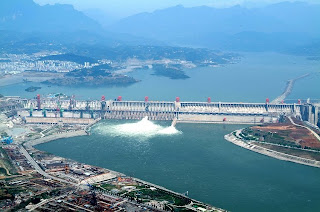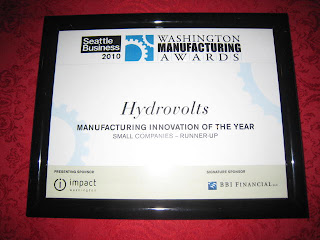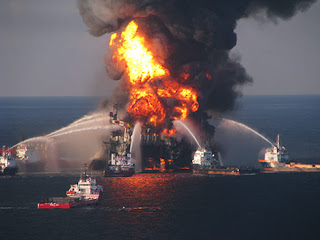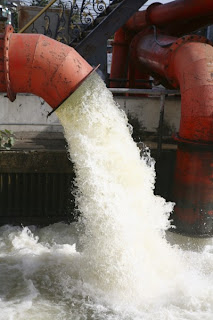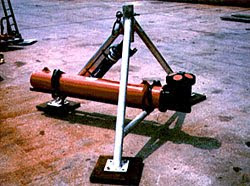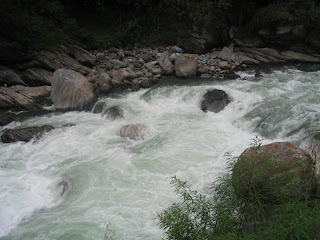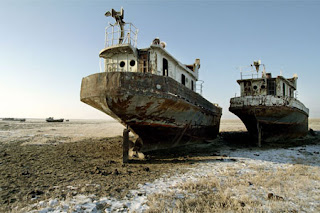Wednesday, June 30, 2010
Hiatus
Thank you to all of our readers.
Taking a break from blogging to focus on other things...
Will return to posting after a while.
Update: I am no longer with Hydrovolts. Check out my new blog.
Taking a break from blogging to focus on other things...
Will return to posting after a while.
Update: I am no longer with Hydrovolts. Check out my new blog.
Monday, June 28, 2010
Crude Behaviors
The Obama Administration's attempt to halt deepwater oil drilling temporarily with a six-month moratorium is, unsurprisingly, under attack. Federal district court judge Martin Feldman of the Eastern District of Louisiana overturned it last week, but his motives are clearly suspect:
Judge Feldman not only held numerous oil and gas interest stocks, but was trading them up to and including the morning of his fateful decision, and doing so out of an admitted realization that he had an appearance of ethical conflict. Feldman owned and was trading Exxon stock, a company whose Gulf of Mexico rigs were losing money at the rate of a half million dollars a day due to the moratorium, during the entire time he was assigned the case. Yet, failing to disclose his appearance of conflict on the record or recuse, Feldman nevertheless proceeded to issue a questionable decision clearly benefitting the oil and exploration industry he is so invested in.So why, when the Government appealed this decision, did they not raise the glaring conflicts of interest?
[snip]
Even more distressing is the fact that it has now been revealed from Judge Feldman’s 2009 financial disclosure, literally just filed and only released this week after demand resulting from his questionable ruling, that Feldman is very heavily invested in Blackrock Financial products. Blackrock is, of course, the single biggest shareholder in BP.
Labels:
energy policy,
fossil fuel,
Lousiana,
politics,
regulation
Tuesday, June 22, 2010
Eight Is Enough
Jon Stewart in one of his typically acerbic pieces on the promise of oil independence:
Coming on the heels of President Obama's speech on the BP spill, and with video clips detailing 4 decades of imprecations and high-minded exhortations from 8 presidents, Stewart complains, roughly, "Fool me once, shame on you. Fool me twice, shame on me. Fool me 8 times, I am a freaking idiot."
We fail to demand real action from our leaders, or to hold them accountable for mouthing bromides. With our current president, I fear the audacity hope has become the folly of wishful thinking. As Pogo said, originally in a poster for Earth Day 1970, "We have met the enemy, and he is us."
Video here.
(h/t earth2tech)
Coming on the heels of President Obama's speech on the BP spill, and with video clips detailing 4 decades of imprecations and high-minded exhortations from 8 presidents, Stewart complains, roughly, "Fool me once, shame on you. Fool me twice, shame on me. Fool me 8 times, I am a freaking idiot."
We fail to demand real action from our leaders, or to hold them accountable for mouthing bromides. With our current president, I fear the audacity hope has become the folly of wishful thinking. As Pogo said, originally in a poster for Earth Day 1970, "We have met the enemy, and he is us."
Video here.
(h/t earth2tech)
Saturday, June 19, 2010
Faint Hope
President Obama's lack of conviction on climate and energy policy is now undeniable. His vacillating remarks on off shore oil drilling over the past few months illustrate his lack of leadership on this, the most critical issue of his presidency.
Eric Pooley over at Grist has an excerpt from his forthcoming book which lucidly surveys the Obama Administration's timeline of timidity. He concludes:
Pooley hopes that public anger will prod a sclerotic Congress into passing a climate bill. However, public anger is attenuating from the steady trickle of bad news and is increasingly eager to look for other targets, particularly within the federal government. The oil lobby and their drill shills in the chattering classes are working hard, incredibly, to recast the oil disaster as an example of why government involvement is bad. (The argument, in defiance of both reason and evidence is roughly: Regulatory oversight failed, thus regulation is worthless, and so government should do nothing, except perhaps foot the bill.) The mob is searching for scapegoats of which to make an example, and the focus is punitive rather than constructive. It is absurd to hope that the public, exhausted from bad news, beset by economic gloom, incited by partisan hacks, and frustrated by collective impotence will spur a Congress captive of corporate interests to do other than pander to the electorate while they stroke entrenched incumbents.
Hope is not a plan. Obama's unwillingness to articulate a bold plan (or even a bold hope) contributes to the perception that our government is adrift. Worse, it reinforces the belief that government is incapable of solving problems, in turn making bold action even harder. On energy policy, this will guarantee the decline of American competitiveness. It is well past time for Obama to be a leader, not a mediator.
Eric Pooley over at Grist has an excerpt from his forthcoming book which lucidly surveys the Obama Administration's timeline of timidity. He concludes:
It is a cruel irony that the epic disaster in the Gulf -- a wakeup call to the need to reduce our dependence on oil -- makes it harder to pass a bill that would help us do so. Expanded offshore drilling (and the revenue it would bring) was the chip Obama hoped to use to draw oil-state senators into a grand bargain that would also include subsidies for nuclear power and carbon capture and storage, with a modest carbon cap in return. The oil spill blew up that idea by taking expanded offshore drilling off the table, at least for now. With few chips left, Obama appears to be hoping that public anger over the spill can help drive a new version of the climate bill. Soon, we’ll know whether he really means it. Democratic leaders in the Senate have been floating the idea of an energy bill without a carbon cap -- which would be yet another failure of nerve by a group of legislators badly in need of adult supervision. Passing a real climate bill will be excruciatingly difficult. Waiting will only make it harder. It’s time for Obama to intervene on the Hill, silence the naysayers inside his own administration, harness the public mood, and make good on his promise to fight.So this is what the audacity of hope looks like--wishing for the First Nerd to remove his figurative glasses and punch back at the bullies. But he won't. Ever cerebral, Obama doggedly appeals to the non-existent good intentions of his opponents, believing that reason and patience will yield agreement. In time, onlookers feel contempt, not sympathy. The notion that Obama will risk any political capital to lead a fight is not a bold hope, but a limp wish.
Pooley hopes that public anger will prod a sclerotic Congress into passing a climate bill. However, public anger is attenuating from the steady trickle of bad news and is increasingly eager to look for other targets, particularly within the federal government. The oil lobby and their drill shills in the chattering classes are working hard, incredibly, to recast the oil disaster as an example of why government involvement is bad. (The argument, in defiance of both reason and evidence is roughly: Regulatory oversight failed, thus regulation is worthless, and so government should do nothing, except perhaps foot the bill.) The mob is searching for scapegoats of which to make an example, and the focus is punitive rather than constructive. It is absurd to hope that the public, exhausted from bad news, beset by economic gloom, incited by partisan hacks, and frustrated by collective impotence will spur a Congress captive of corporate interests to do other than pander to the electorate while they stroke entrenched incumbents.
Hope is not a plan. Obama's unwillingness to articulate a bold plan (or even a bold hope) contributes to the perception that our government is adrift. Worse, it reinforces the belief that government is incapable of solving problems, in turn making bold action even harder. On energy policy, this will guarantee the decline of American competitiveness. It is well past time for Obama to be a leader, not a mediator.
Wednesday, June 16, 2010
Hydrovolts Named 2010 Cleantech Open Semifinalist
Monday night, for the second consecutive year, Hydrovolts was named a semi-finalist in the Cleantech Open. The announcement came Monday evening in the Puget Sound Energy building in Bellevue, Washington at a convivial event attended by members of the local entrepreneur, investor, and cleantech communities.
Last year Hydrovolts was one of the winners in the Pacific Northwest Region and went on to win the National Sustainability Award at the finals in San Francisco.
Leading this year's Hydrovolts team are Brian Peithman, Director of Engineering, and James Marvin, Director of Field Operations and Business Development. Hydrovolts continues to focus on irrigation canals and other constructed watercourses for initial turbine deployments, but also sees great value in applying the Flipwing technology to military applications where distributed renewable energy provides many benefits to national security and saves lives.
Last year Hydrovolts was one of the winners in the Pacific Northwest Region and went on to win the National Sustainability Award at the finals in San Francisco.
Leading this year's Hydrovolts team are Brian Peithman, Director of Engineering, and James Marvin, Director of Field Operations and Business Development. Hydrovolts continues to focus on irrigation canals and other constructed watercourses for initial turbine deployments, but also sees great value in applying the Flipwing technology to military applications where distributed renewable energy provides many benefits to national security and saves lives.
Labels:
Flipwing,
hydrokinetic,
Hydrovolts,
renewable energy,
Washington
Sunday, June 13, 2010
Wooden Turbines
Norwegian company Hydra Tidal plans to test a tidal turbine next month. While many are pursuing different kinds of tidal energy devices, this one is unique for its turbine blades made of wood. Says company founder and R&D director Svein D. Henriksen:
The plan to use floating deployment (as Hydrovolts does) is smart as it is faster, simpler, much cheaper, and doesn't need specialized boats. Still, the technology itself doesn't seem particularly different otherwise, apart from the wooden blades. So, why wood?
“Wood is a porous, homogeneous material — so it has better mechanical and hydrological characteristics than today’s conventional materials such as composites and steel. The major challenge is the actual assembly process, but we believe we have found a good solution.” He points out that using wood in turbine blades is also an environmentally sound choice, especially in a lifecycle perspective.That wood is porous doesn't seem very significant, especially since the pine they plan to use is laminated. Many other materials are "homogeneous" too and the lifecycle advantages are rather minor. At 23 meters long, blade durability may be an issue too, and frequent replacement of weaker blades is no lifecycle or environmental boon. The allegedly better mechanical and hydrological aspects are not further described.
The plan to use floating deployment (as Hydrovolts does) is smart as it is faster, simpler, much cheaper, and doesn't need specialized boats. Still, the technology itself doesn't seem particularly different otherwise, apart from the wooden blades. So, why wood?
80% of the [turbine] can be recycled after its life span, which is more than 30 years. For example, our turbines are made out of glued wood. This material can handle tough ocean environments and they last very long. After the turbines' life end, they can be chopped and used in a bio energy power plant for example.They've done some very clever things in Norway with renewable energy, so it will be worth watching to see how this turns out.
Hydra Tidal has, in cooperation with Harstad University College and Kunnskapsparken Nord AS(Science/Competence park), made a report about CO2 emissions in connection with the production of a complete Morild power plant. CO2 emissions are 40% lower than that of onshore wind power.
Labels:
hydrokinetic,
Norway,
ocean energy,
renewable energy,
tidal
Thursday, June 10, 2010
Putting Litter to Use
A hotel made from trash:
The Corona Save the Beach Hotel, designed by German artist HA Schult, is open until June 7 near Rome's Castel Sant'Angelo, which is located along the Tiber river.This is not Schult's first such effort:
"In the ocean, the trash from all continents meets one another. The trash from Africa meets the trash from Europe, meets the trash from South America," Schult said, pointing to the guitars and shoes plastered across the building.
"The environmental problem is a global problem. We are living in a planet of garbage," said Schult, whose most famous work is "Trash People," an installation of 1,000 human figures made out of trash.
"Trash People" was installed under the Brooklyn Bridge in New York, in front of the Giza Pyramids in Egypt, in Red Square in Moscow, at La Defense in Paris, and along the Great Wall of China.
Wednesday, June 9, 2010
Training Commuters is Difficult
California Bay Area train system Caltrain has received approval from the Federal Railroad Administration to run electric locomotives on the same tracks as their current diesel stock. Apparently this is the first time such approval has been given to any system in the United States. The business case to save the struggling Caltrain was the decisive argument, according to Robert Doty, director of the Peninsula Rail Program which championed the move.
Doty suggested that this result moves the state closer to running high-speed trains on the same tracks:
Doty suggested that this result moves the state closer to running high-speed trains on the same tracks:
The same equipment standards that we have qualified for, the equipment we're looking for, are the same equipment standards for high speed rail. So in effect what we've done is we found the process that needs to be followed and we've done it successfully. Now, they can take our process and expand it for high speed rail, so it is absolutely a precursor for high speed rail.Well, that's a bit like saying that building a Volkswagon Bug paves the way to building a Porsche Carrera.
Labels:
California,
economics,
fossil fuel,
population,
public transit,
trains,
transportation
Monday, June 7, 2010
A Sad Day for Our Oceans
Tomorrow is World Oceans Day. Although proposed by Canada at the Earth Summit in 1992, it was made official only last year.
Tomorrow is also Day 50 of the the worst ecological disaster in US history. (My opinion--there is some depressing competition.)
This year's Oceans Day theme, ironically enough, is "Oceans of Life."
Meanwhile, back at the Wingnut Wurlitzer: Jindal wants to keep drilling. Chevron agrees. Murkowski worries about liability exposure for big oil. Inhofe too. Cornyn thinks we shouldn't try for bold steps on energy policy. Shell Oil says drilling in ANWR is safe. Palin asserts the spill validates "drill, baby, drill." BP remains a corporate psychopath.
Words fail.
Tomorrow is also Day 50 of the the worst ecological disaster in US history. (My opinion--there is some depressing competition.)
This year's Oceans Day theme, ironically enough, is "Oceans of Life."
Meanwhile, back at the Wingnut Wurlitzer: Jindal wants to keep drilling. Chevron agrees. Murkowski worries about liability exposure for big oil. Inhofe too. Cornyn thinks we shouldn't try for bold steps on energy policy. Shell Oil says drilling in ANWR is safe. Palin asserts the spill validates "drill, baby, drill." BP remains a corporate psychopath.
Words fail.
Sunday, June 6, 2010
Permitting Insanity
Why does it take more than 9 years and endless anguish to allow wind turbines in Nantucket Sound, but deepwater oil drilling routinely has environmental impact studies waived, supposedly because massive oil spills are unlikely? The oil industry has received approvals with potentially severe environmental impacts in as little as 10 minutes. Contrast the (over-)abundance of caution for wind and the cozy practice of superficial scrutiny for oil. Recent events make the dissonance especially jarring.
The Cape Wind offshore wind farm is closer than ever to the start of construction. Just more than a week after the explosion of BP's Deepwater Horizon platform, US Interior Secretary Ken Salazar gave formal approval, saying:
The Cape Wind offshore wind farm is closer than ever to the start of construction. Just more than a week after the explosion of BP's Deepwater Horizon platform, US Interior Secretary Ken Salazar gave formal approval, saying:
After careful consideration of all the concerns expressed during the lengthy review and consultation process and thorough analyses of the many factors involved, I find that the public benefits weigh in favor of approving the Cape Wind project at the Horseshoe Shoal location. With this decision we are beginning a new direction in our Nation’s energy future, ushering in America’s first offshore wind energy facility and opening a new chapter in the history of this region.
Friday, June 4, 2010
Hydropower Potential - IV
Alternative Energy eTrack aggregates multiple databases, news sources, insight from industry executives and other sources to produce data on the potential of various kinds of renewable energy. While the service is by subscription, some of the data sometimes appears elsewhere. For example, take this list of the top 10 countries for hydropower:
First, China's capacity is more than double that of the number two country, Brazil.
Second, all of the so-called BRIC countries (Brazil, Russia, India, and China) are in the top six; there is a good correlation of the world's fast-growing and significant economies with hydropower capacity to supply the electrical power these countries need to sustain their growth. The significant investment in renewable generation merits recognition at least as much as the opprobrium over their investment in dirty fossil energy.
Third, hydro dwarfs other renewables in the US, with only wind at the same order of magnitude:
Finally, comparing these numbers to the overall US generating capacity of just more than a terrawatt (1,000,000 MW) shows how relatively paltry is the contribution of renewable sources to our electrical generation.
There is still a long way to go.
1. China - 179,056 MWIt's interesting data for several reasons.
2. Brazil - 81,955 MW
3. United States - 78,054 MW
4. Canada - 75,287 MW
5. Russia - 46,756 MW
6. India - 39,546 MW
7. Norway - 29,317 MW
8. Japan - 22,089 MW
9. France - 20,850 MW
10. Sweden - 16,266 MW
First, China's capacity is more than double that of the number two country, Brazil.
Second, all of the so-called BRIC countries (Brazil, Russia, India, and China) are in the top six; there is a good correlation of the world's fast-growing and significant economies with hydropower capacity to supply the electrical power these countries need to sustain their growth. The significant investment in renewable generation merits recognition at least as much as the opprobrium over their investment in dirty fossil energy.
Third, hydro dwarfs other renewables in the US, with only wind at the same order of magnitude:
Wind 35,296 MWFourth, comparing this data to the capacities cited by the US Energy Information Administration (EIA) shows that there has been little added hydro capacity since 2008, the last year available, but a healthy increase in wind capacity and substantial percentage increases in solar and biomass/biogas.
Biomass 9,391 MW
Geothermal 3,153 MW
Solar (PV) 1,488 MW
Biogas 1,047 MW
Solar (CSP) 900 MW
Finally, comparing these numbers to the overall US generating capacity of just more than a terrawatt (1,000,000 MW) shows how relatively paltry is the contribution of renewable sources to our electrical generation.
There is still a long way to go.
Labels:
Brazil,
BRIC,
China,
energy policy,
fossil fuel,
India,
renewable energy,
Russia,
water,
wind
Wednesday, June 2, 2010
Hear My Train A-Comin'
Would you take a high-speed train that doesn't stop?
The video shows the "non-stop MRT system" of its Taiwanese inventor Peng Yu-lun and is (I think) in Mandarin, but you can get a pretty good idea nonetheless of how passengers use ingenious reusable shuttles to get on and off a high speed train without it stopping or even (much?) slowing down:
English explanation here.
Possible problems:
Update: A friend, working in the PRC for many years writes:
The video shows the "non-stop MRT system" of its Taiwanese inventor Peng Yu-lun and is (I think) in Mandarin, but you can get a pretty good idea nonetheless of how passengers use ingenious reusable shuttles to get on and off a high speed train without it stopping or even (much?) slowing down:
English explanation here.
Possible problems:
- Trains are taller, so existing bridges might need to be rebuilt
- Not everyone in the train can fit in the shuttles, so they couldn't all get off en masse at the stadium station to go to the ball game
- Acceleration of the shuttle may be too exciting for those with heart problems or other health issues
- Most people are too terrified of derailments anyway
- US patent 4,425,851 from 1984. Why did no one do this already?
- A great Peter Tosh tune would be obsolete:
Update: A friend, working in the PRC for many years writes:
It is Mandarin. The platform announcer tells travellers that train 168 non-stop from Beijing to Guangzhou is approaching the station. Passengers travelling in the direction of Guangzhou are to board the shuttle. Then the train's announcer tells passengers disembarking at Wuchang to board the train's shuttle. Lastly there is a welcome to Wuchang station announcement. The inventor explains that he has put together a simple mechanical frame just to demonstrate the basic concept. He then describes the passenger movement for boarding and exiting the non-stop train from Beijing to Guangzhou.
This is very interesting!
Tuesday, June 1, 2010
Augmenting Thermal Power Plants with Hydropower from Cooling Water
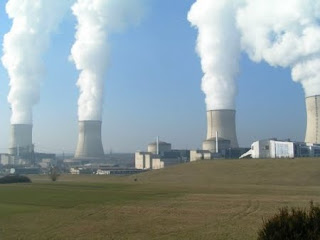 |
Once the steam has passed through the turbine it moves into a condenser where it is cooled back into liquid water, and circulated around to be heated again. Many of the condensers use water to cool the steam. Some plants use a closed loop of cooling water, where the cooling water is itself cooled; in nuclear plants this is the purpose of the tall cooling towers. Steam that escapes is replaced by a fresh supply of water, which is why these plants are typically sited near rivers or by the ocean where there is a large continuous water supply.
Other plants use an open loop or once-through water for their cooling, where water is drawn in continuously for cooling, then discharged back into the river or ocean. These discharges are almost always gravity flows rather than pumped, and these discharges of large amounts of water, running continuously in artificial channels, are perfect for Hydrovolts turbines to generate power, augmenting that made by the main part of the plant. Hydrovolts turbines can generate additional power at modest cost by harnessing these untapped flows; the electricity is sent via the existing transmission infrastructure.
Like most other artificial water flows in constructed waterways, little or no permitting is needed because environmental impacts are minimal. As a result, cost is low and speed of implementation is relatively rapid. This is a solution that lets us take a small, but quick step to a better energy future.
Labels:
Flipwing,
fossil fuel,
hydrokinetic,
Hydrovolts,
nuclear,
renewable energy
Saturday, May 29, 2010
Big Business Responds to Climate Change
The disinformation campaign and faux controversy about climate change has shifted public opinion. The general public has become less certain about the reality of climate change over the past year and more inclined to believe that a real scientific controversy exists. However, a majority of businesses are acting as if the controversy is settled according to accounting firm Ernst & Young:
- 70% of the world's largest companies plan to spend more on efforts to combat climate change
- 80% plan to spend more on energy efficiency measures
- 65% plan to develop products and services related to climate change
- 63% pan to increase transparency of reporting on related areas such as environmental performance, energy use and carbon emissions
- Nearly 50% plan to spend at least 0.5% of revenue on such measures as energy efficiency
With all the uncertainty following Copenhagen, many business commentators were expecting the momentum in climate change investments to slow. Our research has shown something very different.It's quite surprising that business is leading the way in addressing a serious environmental problem on which the public shows increasing confusion and ambivalence. It is tempting to think that business is perhaps starting to see the costs and benefits more clearly; however, it may be more about keeping customers happy than about the operational bottom line: about 90% of the surveyed firms reported that their actions were due to customer demand.
Thursday, May 27, 2010
Washington Manufacturing Awards
The inaugural Washington Manufacturing Awards were held this evening in Seattle, and Hydrovolts finished as the first runner-up for Manufacturing Innovation of the Year in the Small Company category.
Nearly 100 companies were nominated for awards, and Hydrovolts was one of three finalists for the Innovation award. Companies were chosen
Rogers Weed, Director of the Washington State Department of Commerce gave the keynote address on the state and future of manufacturing in Washington. He has a dual focus on aerospace manufacturing because of its size and historical importance and on cleantech "because the Governor told me to" (laughter.) Rogers noted that the economy was improving and recovering from the loss of 190,000 jobs in the state. GDP has grown in Washington for the past 3 quarters, and he sees no likelihood of a "double-dip" recession. Asia remains huge to the state's economy and our export economy remains a national trend-setter not only in exports, but in manufacturing and manufacturing "value-add." Rogers believes and expects Washington to be a leader in the global economy.
In all, a fun evening with good food, a crisp program and great networking with old friends and new acquaintances. Thanks to Impact Washington and the sponsors for the recognition, and hearty congratulations to our friends at MicroGREEN Polymers, who won the top prize!
Nearly 100 companies were nominated for awards, and Hydrovolts was one of three finalists for the Innovation award. Companies were chosen
...by a panel of experts based on criteria that [included] revenue growth (relative to the industry), capital investments, leadership, employee training programs, production quality, productivity, energy conservation and other factors.John Vicklund of Impact Washington helped emcee the awards sponsored by Seattle Business Magazine and RBI Financial. The reception and dinner was held in the Columbia Tower Club, high atop Seattle's tallest building with a sweeping view of the city and Puget Sound.
Rogers Weed, Director of the Washington State Department of Commerce gave the keynote address on the state and future of manufacturing in Washington. He has a dual focus on aerospace manufacturing because of its size and historical importance and on cleantech "because the Governor told me to" (laughter.) Rogers noted that the economy was improving and recovering from the loss of 190,000 jobs in the state. GDP has grown in Washington for the past 3 quarters, and he sees no likelihood of a "double-dip" recession. Asia remains huge to the state's economy and our export economy remains a national trend-setter not only in exports, but in manufacturing and manufacturing "value-add." Rogers believes and expects Washington to be a leader in the global economy.
In all, a fun evening with good food, a crisp program and great networking with old friends and new acquaintances. Thanks to Impact Washington and the sponsors for the recognition, and hearty congratulations to our friends at MicroGREEN Polymers, who won the top prize!
Labels:
Asia,
economics,
Hydrovolts,
jobs,
renewable energy,
Washington
Tuesday, May 25, 2010
Scalable
The Hydrovolts Flipwing Turbine has many compelling advantages compared to other hydro turbines and to other kinds of electricity generators. It has many features, including being complete, compact, modular, safe, simple and scalable.
The Hydrovolts turbine is scalable in two fundamental ways.
First, the Hydrovolts turbine can be built in nearly any size, from very small to quite large. More importantly, the turbine's cross-axis design is rectangular, so it can be built in a broad range of different dimensions. Turbines can be built that are very wide but not very high, or they can be built more squarely. Propeller-type axial turbines always have a circular swept area, so they are ill-suited to water channels that are, for example, broad and shallow. Even with a cowling such turbines are not as adaptable because they cannot scale to arbitrary dimensions like the Hydrovolts turbine.
Second, the typical Hydrovolts turbine is a micro-scale device, and will generate 5-20kW in typical water flows. In very large channels multiple turbines can be deployed side-by-side in the channel, scaling up the power produced by deploying multiple turbines together. Where the water course is deep, turbines can also be positioned one above the other to take advantage of the height of the water column. Turbines can also be spaced one after the other down a water course. Even though any turbine slows the water as it extracts energy, gravity re-accelerates the water as the channel slopes away. Hydrovolts expects turbines typically can be placed 10 per mile, but the maximum rate will depend on the specific watercourse geometry.
Scalable is good. Power from Water.
The Hydrovolts turbine is scalable in two fundamental ways.
First, the Hydrovolts turbine can be built in nearly any size, from very small to quite large. More importantly, the turbine's cross-axis design is rectangular, so it can be built in a broad range of different dimensions. Turbines can be built that are very wide but not very high, or they can be built more squarely. Propeller-type axial turbines always have a circular swept area, so they are ill-suited to water channels that are, for example, broad and shallow. Even with a cowling such turbines are not as adaptable because they cannot scale to arbitrary dimensions like the Hydrovolts turbine.
Second, the typical Hydrovolts turbine is a micro-scale device, and will generate 5-20kW in typical water flows. In very large channels multiple turbines can be deployed side-by-side in the channel, scaling up the power produced by deploying multiple turbines together. Where the water course is deep, turbines can also be positioned one above the other to take advantage of the height of the water column. Turbines can also be spaced one after the other down a water course. Even though any turbine slows the water as it extracts energy, gravity re-accelerates the water as the channel slopes away. Hydrovolts expects turbines typically can be placed 10 per mile, but the maximum rate will depend on the specific watercourse geometry.
Scalable is good. Power from Water.
Labels:
distributed generation,
Flipwing,
Hydrovolts,
renewable energy
Saturday, May 22, 2010
Deepwater Horizon Causes and Lessons
Many investigations lie ahead. President Obama has appointed a commission of inquiry. Industry shills have been hard at work for a month, unhampered by pesky facts. In the interim one of the most detailed analyses I have yet seen is posted at The Oil Drum. The author, a long-time oil and gas geologist, notes that the causes and lessons may change as more facts come to light. The analysis is aided by contibutions from offshore oil industry engineers, bit is also colored in its conclusions by their understandable bias towards perpetuating the industry that sustains their professional standing and provides their economic livelihood.
The principal conclusion pulls no punches:
Offshore oil drilling is not the solution to our energy problems. It is a reckless attempt to perpetuate our failing energy system, a system which cannot be sustained. It stands in the way of advancing real energy solutions. Time grows short.
The principal conclusion pulls no punches:
What can be addressed now is the larger issue that a flawed, risky well plan for the MC 252 well was approved by the MMS, and BP, Anadarko and Mitsui management. Similar or identical plans were undoubtedly approved and used by many operators on other wells drilled in the Gulf of Mexico. A plan that does not include enough cement to overlap the final and previous casing strings, and that does not require running a cement-bond log to ensure the integrity of the seal is a defective plan. The fact that there have not been blowouts on previous wells does not justify the approval and use of an unsafe plan.Similar or identical plans. There are currently 3,858 other offshore platforms in the Gulf of Mexico, each of which can have as many as 20 wells.
Offshore oil drilling is not the solution to our energy problems. It is a reckless attempt to perpetuate our failing energy system, a system which cannot be sustained. It stands in the way of advancing real energy solutions. Time grows short.
Friday, May 21, 2010
Spewing Nonsense
How much oil is spewing from the underwater volcano a mile under the Gulf of Mexico? More than a month after the Deepwater Horizon platform exploded on April 20, then burned and sank two days later, there is still no actual measurement. That there is none is troubling. How the estimates have changed is both instructive and even more disturbing. What might once have been considered spin is now revealed as outright lying. With this latest debacle BP has reached a new nadir in their long history of accidents, lying and greenwashing.
Thursday, May 20, 2010
Ice to Eskimos
In 2008 the average American consumed 30 gallons of bottled water, primarily from single-serving, single-use plastic bottles. That's 320 12-ounce bottles, or nearly one every day. It's obsessive.
There are many reasons not to drink bottled water.
Bottled water costs more than gasoline. It costs up to 10,000 times more than tap water. It uses 2,000 time as much energy. It has 100 times the life cycle costs.
There are many reasons not to drink bottled water.
Bottled water costs more than gasoline. It costs up to 10,000 times more than tap water. It uses 2,000 time as much energy. It has 100 times the life cycle costs.
Tuesday, May 18, 2010
Crude Strategies
The situation in the Gulf is so grim humor can't rise above the sardonic. Thank goodness the problem is relatively small.
Monday, May 17, 2010
National Security Threats Too Great
The following guest post by James Marvin, Director of Field Operations and Business Development at Hydrovolts was previously published in the National Journal's Expert Blogs on Energy & The Environment. James spent 20 years as a Navy SEAL and has seen first-hand the casualties of our oil addiction.
National Security Threats Too Great
by James Marvin
The United States has to pass comprehensive climate and energy legislation. The longer we wait, the more difficult it will become to address the issue. Whether the American Power Act will carry the day, or some other legislation already introduced, remains to be seen. Doing nothing though, is not an acceptable answer and whatever the solution turns out to be it has to be pragmatic and it has to be timely.
National Security Threats Too Great
by James Marvin
The United States has to pass comprehensive climate and energy legislation. The longer we wait, the more difficult it will become to address the issue. Whether the American Power Act will carry the day, or some other legislation already introduced, remains to be seen. Doing nothing though, is not an acceptable answer and whatever the solution turns out to be it has to be pragmatic and it has to be timely.
Friday, May 14, 2010
At the McKinstry Innovation Center
We moved into the McKinstry Innovation Center on Monday and we're now mostly unpacked. It's a beautiful space--light, airy and spacious. I took a few pictures today that give perhaps a sense of our new office and the various shared workspaces.
The third floor lobby entrance--where innovation begins!
The third floor lobby entrance--where innovation begins!
Labels:
Flipwing,
hydrokinetic,
Hydrovolts,
renewable energy,
Washington
Wednesday, May 12, 2010
Distributed Hydropower from Wastewater
The Hydrovolts Flipwing Turbine can generate power in man-made and natural watercourses of many kinds. The initial market is irrigation canals, and there are lots of others, including resource exploration, remote ocean sensors and military uses.
Because of the ingenious cross-axis design of the Flipwing, they can also generate power even in flows that are not clean, or even free of effluvia--flows like those found in sewer and wastewater systems in nearly every community.
There are 16,583 wastewater treatment plants in the United States serving nearly 3/4 of the population. There is growing interest in treating wastewater as a resource rather than something simply to be disposed. The biosolids have obvious application as fertilizer. The sludge can potentially be turned in to energy. Sewage can produce methane for fuel. Washington the Budd Inlet Treatment Plant has a pilot program to do just this. Treatment plant sites also lend themselves to solar installations. There are lots of ways to turn this waste into economic value.
Because of the ingenious cross-axis design of the Flipwing, they can also generate power even in flows that are not clean, or even free of effluvia--flows like those found in sewer and wastewater systems in nearly every community.
There are 16,583 wastewater treatment plants in the United States serving nearly 3/4 of the population. There is growing interest in treating wastewater as a resource rather than something simply to be disposed. The biosolids have obvious application as fertilizer. The sludge can potentially be turned in to energy. Sewage can produce methane for fuel. Washington the Budd Inlet Treatment Plant has a pilot program to do just this. Treatment plant sites also lend themselves to solar installations. There are lots of ways to turn this waste into economic value.
Monday, May 10, 2010
Micro Loans for Micro Power
Hundreds of thousands of people have electricity because of distributed generation from small renewable energy systems financed by micro lending:
This is a great program beautifully suited to regions without existing electrical grid infrastructure, and has the potential to have a lasting and powerfully positive impact on the energy poverty that afflicts much of the developing world. Even small amounts of electricity can change lives for the better by providing lighting for reading, heating and cooking that doesn't burn nasty fuels with toxic byproducts, and the ability to create a business, boosting the local economy.
Such an approach could work with micro hydropower too.
The Solar Home System (SHS) dissemination programme in Bangladesh is considered to be one of the most successful of its kind in the world, bringing power to rural areas where grid electricity supply is neither available nor expected in the medium term.The program started in January 2005 and nearly 350,000 SHSs were installed by last summer, most of which had a rated power output of 50W. Systems came with 3-4 compact flourescent light bulbs. Owners benefit from lighting, especially in their kitchens and courtyards, and also use the systems to charge batteries, power radios, and even run 12V televisions. While statistics are lacking, it appears that some owners are using the power in their small stores and restaurants, boosting their income.
This is a great program beautifully suited to regions without existing electrical grid infrastructure, and has the potential to have a lasting and powerfully positive impact on the energy poverty that afflicts much of the developing world. Even small amounts of electricity can change lives for the better by providing lighting for reading, heating and cooking that doesn't burn nasty fuels with toxic byproducts, and the ability to create a business, boosting the local economy.
Such an approach could work with micro hydropower too.
Saturday, May 8, 2010
National Train Day
In the United States it's National Train Day. I like rail travel, and I prefer it to flying or driving.
Train travel in the US has its good and less good aspects. Here are 10 of each:
10 good things about traveling by train:
Train travel in the US has its good and less good aspects. Here are 10 of each:
10 good things about traveling by train:
- Great scenery through large windows
- Electrical outlets for laptops or other equipment
- Lots of room (more in coach than airlines have in first class)
- A dining car with good-sized tables
- A lounge car
- TSA doesn't do trains
- Show up 5 minutes before departure and get on easily
- No jet engine roar, no seatbelts
- Cheaper than cars or airplanes
- Much smaller carbon footprint
Labels:
carbon footprint,
public transit,
trains,
transportation
Friday, May 7, 2010
Hydrovolts Moves to McKinstry Innovation Center
Monday is moving day!
We've been at our current office for more than a year, but are in the final stages of making our move to the McKinstry Innovation Center down in Georgetown. Our time at WRF has been great and the people--including Ron, John, Loretta, Kim, Thong, Morgan, Dale, and Britt--fantastic. Thanks to all of our friends at WRF for being part of our growth and progress!
Hydrovolts is one of two initial tenants at the McKinstry Innovation Center along with General Biodiesel.
Our new address is
Hydrovolts
210 South Hudson Street
Suite 330
Seattle, WA 98134-2417
Phone numberTBA 206-658-4380. Our website, social media channels, emails, etc. remain unchanged.
Some press on the move here, here, here, and here.
Update: Added phone number and zip+4
We've been at our current office for more than a year, but are in the final stages of making our move to the McKinstry Innovation Center down in Georgetown. Our time at WRF has been great and the people--including Ron, John, Loretta, Kim, Thong, Morgan, Dale, and Britt--fantastic. Thanks to all of our friends at WRF for being part of our growth and progress!
Hydrovolts is one of two initial tenants at the McKinstry Innovation Center along with General Biodiesel.
Our new address is
Hydrovolts
210 South Hudson Street
Suite 330
Seattle, WA 98134-2417
Phone number
Some press on the move here, here, here, and here.
Update: Added phone number and zip+4
Wednesday, May 5, 2010
Idle Plans
In my home town of Toronto, the Board of Health is pushing for legislation to reduce the permitted idling of motor vehicle engines from the current 3-minute limit to one minute. People idling their engines longer face a $125 fine.
The Board acted in part on a report from Dr. David McKeown, Toronto’s medical officer of health, which stated:
Added McKeown, “I understand why people want to get into a warm car, but the price we pay for that is our health.”
The shorter limit was previously adopted by the Ontario city of Burlington, but is "widely ignored" and sporadically enforced.
The Board acted in part on a report from Dr. David McKeown, Toronto’s medical officer of health, which stated:
For every litre of gasoline used, about 2.4 kg of CO2 are produced; for every litre of diesel fuel consumed, about 2.7 kg of CO2 are produced. The Clean Air Partnership estimated that idling in the GTA [Greater Toronto Area] wastes 90 million litres of fuel each year, suggesting that over 215 million tonnes of CO2 are emitted in the GTA each year as a result of idling. Assuming that vehicle ownership is distributed evenly across the GTA, Toronto’s contribution could be 105 million tonnes of CO2 each year as a result of idling.The cars of yesteryear needed warming up because they used heavier motor oil which needed warming to fully lubricate the engine. Modern cars with computer controls need at most 10 seconds before they are ready to drive. Shutting off an engine if it would idle more than 30 seconds will save gas, although there are more effective eco-friendly driving steps.
Added McKeown, “I understand why people want to get into a warm car, but the price we pay for that is our health.”
The shorter limit was previously adopted by the Ontario city of Burlington, but is "widely ignored" and sporadically enforced.
Sunday, May 2, 2010
Laissez Failure
The slow-motion ecological catastrophe in the Gulf of Mexico is horrifying.
The oil slick is now the size of Ohio, and growing by the hour. Edges of it are now reaching land and all along the Gulf coast residents wait with deep foreboding and growing anger as the dimensions of the disaster become clear.
This is not an oil spill, but an oil spilling, as more ruptures from the sea floor, surfaces, and spreads its devastating reach towards shore. 40% of the coastal wetlands in the United States are under threat, as are the majority of the country's oyster and shrimp fisheries. Local fishermen have moved quickly through the 5 stages of grieving as they face the imminent destruction of their livelihood, economic security, their way of life, and their future.
Emergency response began quickly and broad efforts at mitigation are underway. The Obama Administration formed a National Response Team, Louisiana Governor Bobby Jindal is mobilizing the state's National Guard, and locals are taking to their boats to deploy booms to intercept the sprawling slick. Dealing with the immediate crisis is paramount now, yet soon hard questions must be asked, and honestly answered. The critical questions are:
Why did this happen? How do we prevent it happening again?
The oil slick is now the size of Ohio, and growing by the hour. Edges of it are now reaching land and all along the Gulf coast residents wait with deep foreboding and growing anger as the dimensions of the disaster become clear.
This is not an oil spill, but an oil spilling, as more ruptures from the sea floor, surfaces, and spreads its devastating reach towards shore. 40% of the coastal wetlands in the United States are under threat, as are the majority of the country's oyster and shrimp fisheries. Local fishermen have moved quickly through the 5 stages of grieving as they face the imminent destruction of their livelihood, economic security, their way of life, and their future.
Emergency response began quickly and broad efforts at mitigation are underway. The Obama Administration formed a National Response Team, Louisiana Governor Bobby Jindal is mobilizing the state's National Guard, and locals are taking to their boats to deploy booms to intercept the sprawling slick. Dealing with the immediate crisis is paramount now, yet soon hard questions must be asked, and honestly answered. The critical questions are:
Why did this happen? How do we prevent it happening again?
Labels:
Alaska,
economics,
energy policy,
environment,
fossil fuel,
Lousiana,
nuclear,
ocean energy,
offshore wind,
politics,
regulation,
renewable energy,
solar,
sustainability,
Texas,
wind
Friday, April 30, 2010
Hydrovolts is a B Corporation
Hydrovolts has achieved certification from B Labs as a B Corporation--one of only 285 companies in the United States, and one of only 10 in Washington State.
Certification as a B Corporation attests to the values of a business, including those summarized in the B Corporation Declaration of Interdependence:
Certification as a B Corporation attests to the values of a business, including those summarized in the B Corporation Declaration of Interdependence:
We envision a new sector of the economy which harnesses the power of private enterprise to create public benefit.
This sector is comprised of a new type of corporation, the B Corporation, which is purpose-driven and creates benefit for all stakeholders, not just shareholders.
Thursday, April 29, 2010
Distributed Hydropower for Remote Ocean Devices
There are many users who want to place electronic devices in remote ocean locations where power is not available from the electrical grid. These remote ocean devices (often sensors of some kind) are powered by batteries; however, today's state-of-the-art solutions are expensive and inconvenient.
For example, researchers at the University of Washington frequently want to deploy Acoustic Doppler Current Profilers (ADCPs) or other devices to take measurements under water over the course of weeks, months or longer. Running power through a cable from shore is impractical and costly, but the alternative actually used has a stiff price too: a disposable battery that costs $500 and lasts a mere 10 days, after which it must be replaced. In addition to the recurring cost of replacement batteries, there is the enormous cost of a boat and crew to do the replacement--often $1,000 per hour or more. In the deeper ocean farther form shore, boat costs can easily top $100,000 per day.
For small ocean power, the Hydrovolts turbine paired with a rechargeable battery replaces the current disposable battery solution, providing a capital ROI of substantially less than one year.
For example, researchers at the University of Washington frequently want to deploy Acoustic Doppler Current Profilers (ADCPs) or other devices to take measurements under water over the course of weeks, months or longer. Running power through a cable from shore is impractical and costly, but the alternative actually used has a stiff price too: a disposable battery that costs $500 and lasts a mere 10 days, after which it must be replaced. In addition to the recurring cost of replacement batteries, there is the enormous cost of a boat and crew to do the replacement--often $1,000 per hour or more. In the deeper ocean farther form shore, boat costs can easily top $100,000 per day.
For small ocean power, the Hydrovolts turbine paired with a rechargeable battery replaces the current disposable battery solution, providing a capital ROI of substantially less than one year.
Tuesday, April 27, 2010
Time Grows Short
Oil is a finite resource.
Production peaked in the US decades ago, and the global peak is happening now, if it hasn't already. The transition to a new energy economy must happen because our ability to produce fresh supply will decline, even as economic development quickens throughout the developing world, boosting demand. There are other reasons too: climate change, energy security, and addressing energy poverty, the root of poverty generally throughout the world.
Making the transition is an urgent need:
Production peaked in the US decades ago, and the global peak is happening now, if it hasn't already. The transition to a new energy economy must happen because our ability to produce fresh supply will decline, even as economic development quickens throughout the developing world, boosting demand. There are other reasons too: climate change, energy security, and addressing energy poverty, the root of poverty generally throughout the world.
Making the transition is an urgent need:
The most critical question is how much time we have to make the transition. A fully equipped hospital with on-duty surgeons and staff may be the ideal technology for a critically injured patient. But they mean little to such a patient if we are in the position of having to build the hospital and train the surgeons and staff before administering treatment. I think this analogy aptly describes our current predicament. If you miscalculate concerning the time question, it will not matter how clever human beings are.Our Earth, the patient, suffers from a growing number and severity of injuries. Delivering the cure will take substantial time and investment. What are we waiting for?
Sunday, April 25, 2010
Compact
The Hydrovolts Flipwing Turbine is designed to be complete, compact, modular, safe, simple and scalable.
I previously posted about how it is simple and complete.
It's also a compact solution. Other hydrokinetic turbines for micro-generation (i.e. less than 100kW) are much less so. Almost all use some kind of raft and place their generator and electronics above the water line. This solves one problem--how to keep the electronics dry--but introduces others:
Compact is good. Power from Water.
I previously posted about how it is simple and complete.
It's also a compact solution. Other hydrokinetic turbines for micro-generation (i.e. less than 100kW) are much less so. Almost all use some kind of raft and place their generator and electronics above the water line. This solves one problem--how to keep the electronics dry--but introduces others:
- Transmission--The rotor under water must somehow connect to the generator above it. Shafts, belts or chains can be used, but all have drawbacks, including efficiency loss, added maintenance burden, additional points of failure, and more mechanism that can entrain debris or become fouled.
- Efficiency--Vertical axis turbines with a lift design, (e.g. a Darrieus turbine) lose efficiency unless they are perfectly vertical, However, extending the shaft to the surface makes maintaining vertical alignment nearly impossible.
- Adaptability--By using a raft, other turbines must be sited close to the surface.
- Cost--Additional materials and a larger design add to the cost to build, to transport, and to deploy.
- Sustainability--The added cost is not just in money, but also in embodied energy and carbon footprint.
Compact is good. Power from Water.
Labels:
Flipwing,
hydrokinetic,
Hydrovolts,
renewable energy
Thursday, April 22, 2010
Energy Security
Earth Day turned 40 today. For many Earth Day is an occasion to think green, hope for a less polluted future, advocate for renewable energy and perhaps push for a solution to climate change.
Others dismiss Earth Day as a symbol of mushy-minded ecomania that elevates the environment over the economy. It's a false choice, but the notion that doing something about the environment will cost the economy persists. Those who are skeptical about climate change are generally the same as those who are negative about renewable energy.
However, there are other reasons to support and promote renewable energy, and a big one is energy security. If it's renewable we don't need to rely on the supply of something like oil or uranium that has to come from somewhere else, possibly a country or region hostile to us.
Energy security matters. Most casualties in Iraq and Afghanistan come from the necessity of fuel transport--the supply chain is long and highly vulnerable.
Failing to make the speediest transition to renewable energy is bad policy for many reasons. It costs lives. It costs money. It funds those hostile to us. And it's futile, because the current energy model is not sustainable. Even the military recognizes that we need to get beyond oil because we're running out of the stuff.
Others dismiss Earth Day as a symbol of mushy-minded ecomania that elevates the environment over the economy. It's a false choice, but the notion that doing something about the environment will cost the economy persists. Those who are skeptical about climate change are generally the same as those who are negative about renewable energy.
However, there are other reasons to support and promote renewable energy, and a big one is energy security. If it's renewable we don't need to rely on the supply of something like oil or uranium that has to come from somewhere else, possibly a country or region hostile to us.
Energy security matters. Most casualties in Iraq and Afghanistan come from the necessity of fuel transport--the supply chain is long and highly vulnerable.
Failing to make the speediest transition to renewable energy is bad policy for many reasons. It costs lives. It costs money. It funds those hostile to us. And it's futile, because the current energy model is not sustainable. Even the military recognizes that we need to get beyond oil because we're running out of the stuff.
Tuesday, April 20, 2010
Hydrovolts RFP
Yesterday we put out an RFP for the design and realization of a sensor system on our Alpha-1C prototype.
Summary:
Summary:
Hydrovolts is seeking a Contractor to design and install sensor and data collection capability on a submersible hydrokinetic turbine to measure rotor torque and rpm while operating in water flow rates between 1 and 8 knots of current speed. The deadline for Proposals is April 30, 2010 and the selected Proposal will be announced May 3, 2010 with work to begin immediately.We expect a lot more work of this kind in the future as well; the ideal solution will be reusable on this and future machines. See the RFP for more details or contact Hydrovolts Director of Engineering' Brian Peithman at 206-336-5560.
Sunday, April 18, 2010
Hydrovolts Expands Leadership Team
We're really pleased to announce a new addition to our team!
James Marvin, a former U.S. Navy SEAL Commander, started this past Monday as our Director of Business Development and Field Operations.
Burt Hamner, Hydrovolts CEO was enthusiastic:
James and his family recently moved to the Seattle area from Virginia. The way they planned and executed the move is illustrative of both James' talents and a broader trend in relocation for top professionals. You can read more in last week's profile in the Wall Street Journal.
James has hit the ground running. Tomorrow he and Hydrovolts Director of Engineering Brian Peithman are in the field near Yakima to do some advance work ahead of deployment of our first demonstration project later this spring.
Welcome James!
James Marvin, a former U.S. Navy SEAL Commander, started this past Monday as our Director of Business Development and Field Operations.
Burt Hamner, Hydrovolts CEO was enthusiastic:
We are excited to expand our team, and James’ expertise in both federal government relations and remote field operations will be integral to the company’s evolution and growth. James will not only implement turbine demos in canals and waterways around the world, but also help Hydrovolts do business with governmental organizations that work in remote, austere environments that can benefit from Hydrovolts’ renewable, fuel-free power generation technology.James has 20 years of leadership experience in the most demanding and challenging environments around the world. His most recent assignment was Director of Operations for Naval Special Warfare Group Four (NSWG-4) where he managed maritime mobility platform operations for the U.S. Special Operations Command (USSOCOM) in riverine, coastal, and open ocean environments. He has global operational experience and has worked in the Pacific, South America, the Middle East, Europe, Africa as well as the U.S.
James and his family recently moved to the Seattle area from Virginia. The way they planned and executed the move is illustrative of both James' talents and a broader trend in relocation for top professionals. You can read more in last week's profile in the Wall Street Journal.
James has hit the ground running. Tomorrow he and Hydrovolts Director of Engineering Brian Peithman are in the field near Yakima to do some advance work ahead of deployment of our first demonstration project later this spring.
Welcome James!
Friday, April 16, 2010
Rapa Nui's Descent into Darkness
Many people insist, with all manner of justifications, that we can not, we should not, change the way we generate or use energy because we're not running out of oil, the climate isn't changing, and we aren't destroying our ecosystems everywhere one looks. Cornucopia forever.
Yet the inhabitants continued on. The forest dwindled to nothing and the soil washed away, depleted. Crop yields dropped. Felling trees destroyed animal habitat and then the animals. Food became scarce, leading to famine, inter-tribal warfare and eventually cannibalism. The population crashed in a mass die-off.
What did the Easter Islander who cut down the last palm tree say while he was doing it?A foreshadowing of the looming twilight of the Oil Age. The way of life on Easter Island wasn't negotiable either. The result?
[snip]
In fact, the question can be asked more broadly: “What were the thought processes and discussions amongst the inhabitants of Easter Island leading up to the removal of the last remnants of forest?” This could be seen, perhaps, as a hypothetical exploration, rooted in a real historical event, of “the psychology of resource depletion denial.”
As the forests shrunk in area and the annual percentage rate of depletion steadily increased, at some point, someone must have realised that the situation was not sustainable and said as much. The island is not that big and what was happening at one end would have been common knowledge at the other end.
Yet the inhabitants continued on. The forest dwindled to nothing and the soil washed away, depleted. Crop yields dropped. Felling trees destroyed animal habitat and then the animals. Food became scarce, leading to famine, inter-tribal warfare and eventually cannibalism. The population crashed in a mass die-off.
Wednesday, April 14, 2010
Let's Go LEGO
LEGO is equipping and stimulating the next generation of cleantech inventors. This is great, but where's the hydropower turbine?
Sadly, biomass fans are totally out of luck.
(h/t Fast Company)
The Renewable Energy Add-on Set is designed as an addition to the Simple & Motorized Mechanisms Set, the core set in our Machines & Mechanisms range. When the Renewable Energy Add-On Set is combined with the customized activity pack, students will explore renewable energy sources; investigate energy supply, transfer, accumulation, conversion, and consumption; and use measurements and data analysis to describe and explain outcomes through hands-on activities and exciting, real-life models.The LEGO folks also write:
Students will experiment using energy from their own bodies and the three main energy sources – solar, wind, and water – to generate, store, and use power.Water is one of the big three – all right! Perhaps the wind rotor disconnects from the generator so it could be placed under water and use some kind of gears or belt to turn the generator above water. I'm going to get one when it is available this Fall (in time for Christmas I suppose.)
Sadly, biomass fans are totally out of luck.
(h/t Fast Company)
Tuesday, April 13, 2010
The World's Only Carbon-Negative Country
Low fossil fuel use and a strong policy to protect forests makes it unique:
Run on Buddhist principles of respect for nature, Bhutan is the only country among 194 U.N. members to have formally told the United Nations this year that it is now "climate negative" -- soaking up more greenhouse gases more than it emits.Bhutan, a tiny Buddhist kingdom in the Himalayas is also noteworthy as the only country in the world that calculates its Gross National Happiness.
Saturday, April 10, 2010
Partisan Challenge
A famous American, fiercely partisan on any number of policy areas, nonetheless said this:
Such a viewpoint was not remotely controversial at the time. One suspects that if President Obama or most any other leader were to speak these exact words today the resulting partisan firestorm of criticism would be intense and vitriolic. Recent polling suggests that a slim majority of Americans are now willing to throw the environment under the economic bus. The anemia of the current "recovery" is doubtless responsible for much of this sentiment, but the lack of unequivocal support for environmental protection by our leaders is also to blame.
If we've learned any lessons during the past few decades, perhaps the most important is that preservation of our environment is not a partisan challenge; it's common sense. Our physical health, our social happiness, and our economic well-being will be sustained only by all of us working in partnership as thoughtful, effective stewards of our natural resources.Who was the speaker? This same proud conservative also took credit for his fundamentally conservative viewpoint that the economy does not utterly trump the environment:
I'm proud of having been one of the first to recognize that States and the Federal Government have a duty to protect our natural resources from the damaging effects of pollution that can accompany industrial development.
Such a viewpoint was not remotely controversial at the time. One suspects that if President Obama or most any other leader were to speak these exact words today the resulting partisan firestorm of criticism would be intense and vitriolic. Recent polling suggests that a slim majority of Americans are now willing to throw the environment under the economic bus. The anemia of the current "recovery" is doubtless responsible for much of this sentiment, but the lack of unequivocal support for environmental protection by our leaders is also to blame.
Labels:
climate change,
energy policy,
environment,
politics
Thursday, April 8, 2010
Complete
The Hydrovolts Flipwing Turbine is designed to be complete, compact, modular, safe, simple and scalable.
I previously posted about how it is simple.
It's also a complete, ready-to-use product right out of the box. Part of simple deployment, as I wrote last time, is not needing a lot of assembly or complicated hook-ups to other components. The Hydrovolts turbine arrives with all parts necessary to make power. The power cable that comes out of the turbine provides 110V or 220V depending on the prevailing standard. It can be wired straight into an electrical panel. We can even provide it with a simple power strip on the end!
It's complete in the same way that a diesel generator bought from the hardware store is. You buy it, bring it home, start it up, and start plugging things into it. Actually, it's even more complete than that: you never need to bother with fuel.
Complete is good. Power from Water.
I previously posted about how it is simple.
It's also a complete, ready-to-use product right out of the box. Part of simple deployment, as I wrote last time, is not needing a lot of assembly or complicated hook-ups to other components. The Hydrovolts turbine arrives with all parts necessary to make power. The power cable that comes out of the turbine provides 110V or 220V depending on the prevailing standard. It can be wired straight into an electrical panel. We can even provide it with a simple power strip on the end!
It's complete in the same way that a diesel generator bought from the hardware store is. You buy it, bring it home, start it up, and start plugging things into it. Actually, it's even more complete than that: you never need to bother with fuel.
Complete is good. Power from Water.
Tuesday, April 6, 2010
Arid Sea
How does one of the most massive bodies of water in the world vanish?
In the case of the Aral Sea, with sickening speed. What was once the world's 4th largest freshwater lake now is just 10% of its former size.
The causes are several: misguided economic development that ends up destroying, not creating jobs and economic vitality. Unsustainable practices. Grasping behaviors suggesting this may be an early harbinger of water wars to come.
Yet another example of the tragedy of the commons. The practices that are destroying the Aral Sea are not dissimilar to those that are destroying the oceans. Or the mountains. Or our climate.
In the case of the Aral Sea, with sickening speed. What was once the world's 4th largest freshwater lake now is just 10% of its former size.
The causes are several: misguided economic development that ends up destroying, not creating jobs and economic vitality. Unsustainable practices. Grasping behaviors suggesting this may be an early harbinger of water wars to come.
Yet another example of the tragedy of the commons. The practices that are destroying the Aral Sea are not dissimilar to those that are destroying the oceans. Or the mountains. Or our climate.
Sunday, April 4, 2010
I Guess They Didn't Need a Weatherman
Interesting.
A London developer will complete construction this June on the Strata SE1, which it claims "is the first development in the world where wind turbines have been integrated within the fabric of the building."
How much power will these turbines make?
A London developer will complete construction this June on the Strata SE1, which it claims "is the first development in the world where wind turbines have been integrated within the fabric of the building."
How much power will these turbines make?
The three five bladed nine metre diameter wind turbines are rated at 19kW each and are anticipated to produce 50MWh of electricity per year... approximately 8% of Strata SE1's estimated total energy consumption.Hmm. To achieve 50MWh of output, the turbines must generate a continuous average over the year of about 1.9kW each. So Brookfield Europe, the developer, apparently infers that the actual generation will be a mere 10% of the "rated" output, which is really rather poor. A nice round figure of 10% also sounds like a guess:
Labels:
distributed generation,
economics,
Europe,
renewable energy,
sustainability,
UK,
wind
Subscribe to:
Comments (Atom)











